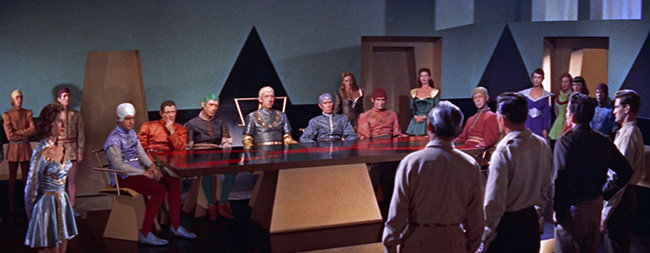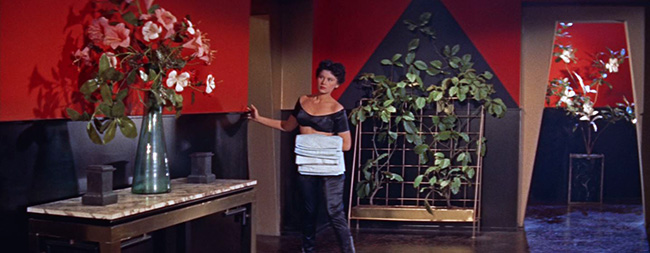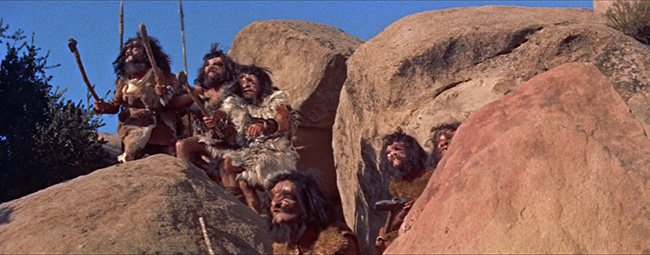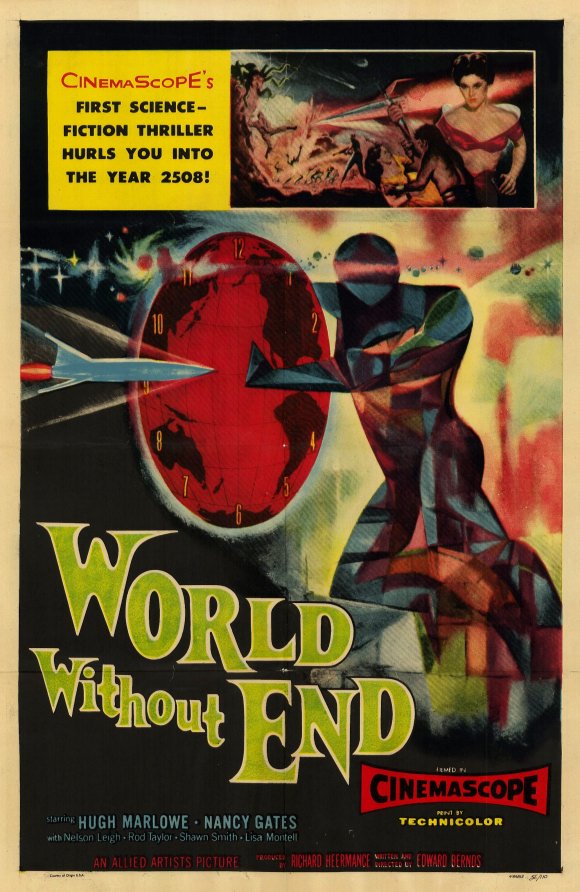
While on a mission to Mars – which, ambitiously, also happens to be the first manned flight into space – Rocketship XRM (not to be confused with Rocketship X-M) travels so fast that it is flung into an “exponential time displacement” and leaps from 1957 to 2508. Crash landing back on Earth, only gradually do the four passengers realize this world is the same one they left, and that several centuries have passed. High levels of radiation are detected everywhere. Inside a cave they do battle with two spiders the size of dogs. In the mountains and valleys they encounter disfigured men dressed in prehistoric garb and flinging spears, many of them having only one eye; the explorers decide to call them Mutates. Eventually they uncover a tunnel which leads to an underground civilization. Here, the last vestiges of humanity have become docile pacifists in the wake of nuclear Armageddon, so weak that each successive generation is smaller in number and more sickly; the crew of XRM reckons they are witnessing the death of the human race. The Allied Artists release World Without End (1956) is something of a camp classic, and it’s just been released on Blu-Ray by Warner Archive, which has been hitting it out of the park this year with cult releases; this follows excellent high definition transfers of the stop-motion dinosaur romps When Dinosaurs Ruled the Earth (1970) and The Valley of Gwangi (1969). Though World Without End isn’t as lovingly regarded and is certainly not a special effects showcase, the film has in its favor a Technicolor Cinemascope presentation that makes it easy on the eyes, lending a similar visual luster as the Technicolor The War of the Worlds (1953) and This Island Earth (1955), and the Cinemascope Forbidden Planet (1956), even if the sights are not nearly as spectacular as any of those films. No, World Without End is largely set in underground rooms, with not a single alien or apocalyptic vista to fill the wide frame. You see, the real subject of World Without End is girls, girls, girls.

Servant girl Deena (Lisa Montell)
As it happens, the men of the future have evolved into wimpy intellectuals, but the women (as it’s mentioned on multiple occasions) are unusually vivacious. Naturally, the women have become dissatisfied with their mating choices, and they admire the muscles on the newcomers: a shirtless Rod Taylor (The Birds) evokes an awed stare. (And hey! He does look good!) Bravery and “guts” are valued too, though the society’s all-male council, led by the elderly Timmek (Everett Glass, Invasion of the Body Snatchers), detest the spacemen’s use of weapons, having developed a postwar aversion to all arms. It’s perfectly clear: only the Greatest Generation can save them. Appropriately enough, the production artist is pin-up artist extraordinaire Alberto Vargas, whose “Varga Girls” in Esquire and elsewhere inspired the young fighting men of WWII – and the nose art of their fighter planes. World Without End tells us that guns and virility are all that can save mankind, and in discovering the abundance of leggy females eager for real loving, the crew of XRM find fast comfort in the apocalypse. As Dr. Galbraithe (Nelson Leigh, Gunfight at the O.K. Corral) confesses, “I’m a widower and a grandfather, and I’ll never see 50 again. But this afternoon I had the unique experience of being flattered, sought after, and catered to by several beautiful women who competed for my attention. Gentlemen, I can only describe the experience as being, well, exhilarating.” Rocketship captain John Borden (Hugh Marlowe, The Day the Earth Stood Still, Earth vs. the Flying Saucers) falls for Timmek’s beautiful daughter, Garnet (Nancy Gates, Comanche Station). Taylor’s Herbert Ellis even finds himself at the center of a love triangle between the vivacious redhead Elaine (Shirley Patterson, It! The Terror from Beyond Space) and the shy servant girl Deena (Lisa Montell, Pearl of the South Pacific), a survivor of the upper world who has escaped the mutating effects of radiation.

The Mutates, or Beasts, attack.
Eventually Ellis chooses Deena, after she risks her life to expose a plot hatched by the jealous Mories (Booth Colman) to frame them for murder and theft of guns. Deena then joins the men on an expedition to the surface world where they use a bazooka to clear the neighborhood of Mutates, and where Borden has a climactic duel with the Mutate chief. The fact that Deena has to translate the Mutate ooga-booga language for the men makes it clear that we’re in just another iteration of some well-worn pulp SF, and Deena is the beautiful native girl guiding our white explorers against hostile tribes. These are the tropes that close out a story which otherwise balances sex fantasy with social commentary borrowed (and mutated) from H.G. Wells, with its stratification of Eloi and Morlock types. In fact, the Wells estate sued for plagiarism, which is amusing, because The Time Machine had nothing to fear from silly schlock like World Without End. (Taylor would go on to star in George Pal’s straight adaptation of the original work.) Writer-director Edward Bernds (The Bowery Boys Meet the Monsters) is happy to mash together as many familiar genre elements as he can get his hands on, and it’s pretty clear from the start that this is just a slicker, prettier incarnation of B-movies like Cat-Women of the Moon (1953) and Fire Maidens of Outer Space (1956); Bernds’ only directive was to appropriate some rocketship footage from Flight to Mars (1951), a film from Allied Artists’ former incarnation, Monogram Pictures. The most compelling scenes come early on, when the astronauts land in snow-covered mountains, trying to determine if they’re on one of Mars’ polar caps or some other alien world; but imagination runs dry by the time Taylor has freed himself from the giant spider’s cobwebs. No, the film is most enjoyable today because of its limited imagination, where everyone conforms to our heroes’ expectations, and the world can only be saved by sheer manliness: it’s like a movie written by Futurama‘s Zapp Brannigan. Appropriately, in the 90’s it was riffed live by Mystery Science Theater 3000 at one of its early conventions.










